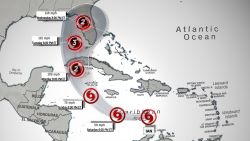Editor’s Note: Affected by the storm? Use CNN’s lite site for low bandwidth.
Tropical Storm Ian, the ninth named storm of the 2022 Atlantic hurricane season is forecast to reach up to Category 4 hurricane strength before hitting Florida next week. If it does, it will be the first major hurricane to impact the state since 2018.
Ian was located about 255 miles south of Kingston, Jamaica, as of 6 p.m. Saturday and moving west at 16 mph, according to the National Hurricane Center. “Significant strengthening is forecast during the next few days,” the center said.
The forecast shows Ian “as a major hurricane over the eastern Gulf when it is approaching the west coast of Florida,” after briefly passing over Cuba at or near major hurricane strength, the center said Friday. The entire Florida panhandle and nearly the entire western coast of the state could be at risk, according to the most recent forecast cone from the hurricane center.

After strengthening overnight, Ian – earlier known as Tropical Depression Nine – has maximum sustained winds of 45 mph (75 km/h) and is forecast to reach hurricane status within the next two days as it approaches the Cayman Islands by early Monday.
Ian is then expected to rapidly intensify and become a Category 3 hurricane before it reaches far western Cuba early Tuesday. Conditions are extremely favorable for strengthening and the forecast from the National Hurricane Center now brings Ian to a Category 4 hurricane over the Gulf of Mexico.
“Since Ian is not expected to remain over Cuba long, little weakening is expected due to that land interaction,” the hurricane center explained.
Forecast models on Saturday afternoon vary on where Ian may make landfall on Florida’s coast. The European model shows landfall near Tampa on Thursday morning, while the American model shows landfall near Pensacola Friday morning. There also continues to be a considerable amount of uncertainty with the track during the middle of next week.
The official hurricane center track splits the difference between the models, showing landfall north of Tampa on Thursday morning.
Florida Gov. Ron DeSantis expanded an emergency order from 24 counties to include the whole state Saturday, citing “foregoing conditions, which are projected to constitute a major disaster.”
“The Florida Division of Emergency Management, working together with the National Hurricane Center to evaluate weather predictions, has determined there is a continuing risk of dangerous storm surge, heavy rainfall, flash flooding, strong winds, hazardous seas, and isolated tornadic activity for Florida’s Peninsula and portions of the Florida Big Bend, North Florida, and Northeast Florida,” the order states.
Under the state-level emergency order, members of the Florida National Guard will be activated and on standby awaiting orders.
President Joe Biden on Saturday approved a disaster declaration for the tropical storm, which is forecast to reach the state later this week as a hurricane.
“The President’s action authorizes the Department of Homeland Security, Federal Emergency Management Agency (FEMA), to coordinate all disaster relief efforts which have the purpose of alleviating the hardship and suffering caused by the emergency on the local population,” the White House said in a news release.
Ian could be Florida’s first major hurricane in four years
If it strengthens to a Category 3 or higher before reaching Florida, Ian would be the first major hurricane to make landfall there since Hurricane Michael in 2018, which was a monster Category 5 storm when it collided with the Florida panhandle. Michael also underwent rapid intensification before it made landfall, a phenomenon which has been made more likely as ocean temperatures warm due to the climate crisis.
A hurricane warning was issued for Grand Cayman, and a tropical storm watch is in effect for Little Cayman and Cayman Brac in the Cayman Islands. A tropical storm watch for Jamaica has been discontinued.
The governor urged those in the potential path of the storm to prepare.
“This storm has the potential to strengthen into a major hurricane and we encourage all Floridians to make their preparations,” DeSantis said in a news release. “We are coordinating with all state and local government partners to track potential impacts of this storm.”
Forecasters urge for residents to prepare
It has been a slow start to what was forecast to be an above-average hurricane season. Only one storm has made landfall in a US territory, and no hurricane has made landfall or threatened the contiguous states.
Now, a week past the peak of hurricane season, the tropics seem to have woken up, and forecasters are concerned people have let down their guard.
“After a slow start, the Atlantic hurricane season has ratcheted up quickly,” Phil Klotzbach, research scientist at Colorado State University, tweeted.
“People tend to lower their guard and think, oh, yeah, we’re out of the woods,” Maria Torres, hurricane center spokesperson, told CNN. “But in reality, the season continues. We are still in September; we still have October to go. Anything that forms over either the Atlantic or the Caribbean is something that we need to keep monitoring very closely.”
The Atlantic hurricane season ends November 30.
No matter what, if you live in the Caribbean, Florida and other states along the Gulf Coast, pay attention to the updated forecasts this weekend into early next week.

























